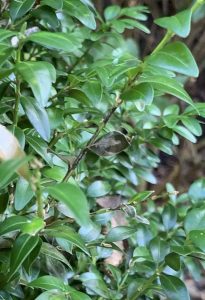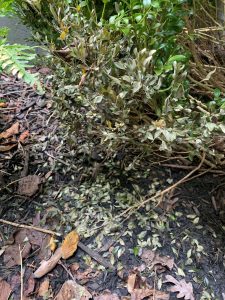Heather N. Kolich, ANR Agent, UGA Extension Forsyth County

Boxwood shrubs (Buxus sempervirens) were imported to North America in the 1650s, but they were features in European and Asian gardens long before that. Durable, versatile, and evergreen, boxwoods are used to create garden walls, sculpted walks, topiaries, and formal parterre gardens. They’re also a popular choice for foundation plantings around homes.
So, when a fungal disease known as boxwood blight (Calonectria pseudonaviculata)arrived on our eastern shores in 2011, it was bad news for horticulture. Affected plants dropped their leaves and died. Fungicides didn’t provide adequate control and the disease spread easily. Managers of historic gardens lamented.
When boxwood blight was first confirmed in Georgia a few years later, there was still no cure for the disease. Management focused on preventing the spread of the fungus through the removal of afflicted plants and replacing boxwood plantings with different species of shrubs that are not susceptible to boxwood blight. It seemed boxwoods were destined to move from icons of history to relics of it.
Now, after several years of research on boxwood blight, University of Georgia Extension Plant Pathologist Jean Williams-Woodward reports there may be hope. Some boxwoods that were inoculated with boxwood blight in her disease-response test plots put out new growth and showed signs of recovering after exhibiting disease symptoms. The outstanding difference between the recovering boxwoods and those that died seems to be the level of reinfection or secondary exposure to fungal spores.

Boxwood blight spores are too heavy for wind dispersal. Instead, they are sticky and catch rides to new plants on pet fur, bird feathers, clothing, tools, and shoes. Overhead irrigation can also spread the spores through drips and soil splash. Boxwoods in test plots with overhead sprinklers and/or lots of visitors, such as grad students pruning the plants and cats rubbing against lower branches, suffered continual fungal reinfection. Plants that were more isolated and were not irrigated by overhead sprinklers showed signs of recovery after the initial, intentional infection.
Signs and symptoms of boxwood blight include leaf spots, leaf discoloration (gray to tan) leaf drop, and black lesions on stems. While severely infected boxwoods – and boxwoods adjacent to them – should be removed, management practices to stop spore spread may help maintain the health of other boxwoods and related plants in the landscape. These include:
- Avoid overhead irrigation; shift to drip irrigation if needed.
- If pets are present (even if they’re not yours), prune lower branches up and out of reach of rubbing pet backs.
- Disinfect tools and shoes with 70% ethanol, isopropyl alcohol, or regular Lysol spray.
- Clean up and remove leaf litter.
- Apply mulch to reduce soil splash onto leaves.
- Always begin maintenance with healthy plants, moving to diseased plants at the end.
- Prune out and remove branches showing early signs of boxwood blight, disinfecting pruners after every cut.
While fungicides can help protect healthy plants from infection, they cannot cure an infected plant. In landscapes that have suffered boxwood blight heavily, alternative, boxwood blight-resistant shrub species may be the best option.